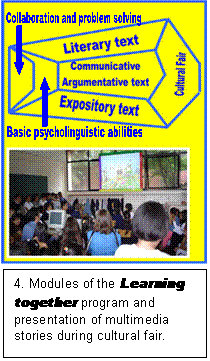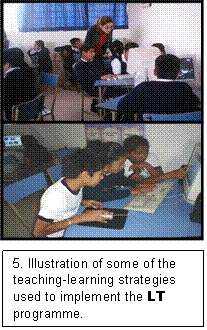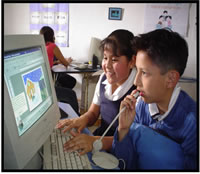MirandaNet presence in the UK and throughout the World
International | Africa | Bangladesh | Chile | China | CzechMiranda | Japan | Macedonia | Mexico | MiraNet | MirandaNorth | Poland | Regional | Romania | Star | Taiwan | Thailand | UK-Japan Science | UK-China Links | USA
 “Learning
Together”
“Learning
Together”
The Creation of Communities of Inquiry Supported by ICT
S.M. Rojas-Drummond*, C.D. Albarrán, M.G. Vega, M. Zúñiga & M. Vélez
Faculty of Psychology, National Autonomous University of Mexico
- Introduction
- General Description of the Programme
- Implementation of the Programme in each Grade
- Conclusions
- Bibliography
III. Implementation of the Programme in each Grade
a) Multimedia stories
 In
4th grade, we promote children’s enjoyment, comprehension and production
of literary texts, including stories. In particular, we strengthen abilities
such as the recognition of different literary genres and the detection of
story structures and styles. At the same time, children produce in teams their
own stories. In this process, they search for story ideas, they then integrate
these ideas into a plan and translate their plan into a coherent text. Later
they revise and polish their stories. We encourage that their texts include
vivid descriptions, interesting dialogues, cohesive narratives and the use
of humor, suspense and drama.
In
4th grade, we promote children’s enjoyment, comprehension and production
of literary texts, including stories. In particular, we strengthen abilities
such as the recognition of different literary genres and the detection of
story structures and styles. At the same time, children produce in teams their
own stories. In this process, they search for story ideas, they then integrate
these ideas into a plan and translate their plan into a coherent text. Later
they revise and polish their stories. We encourage that their texts include
vivid descriptions, interesting dialogues, cohesive narratives and the use
of humor, suspense and drama.
Once children's stories are written in a word processor, they convert them into a multimedia version. For this purpose, they use pictures, animation, voice and music, with the help of Power Point and Internet. The stories produced reflect the work of the team and represent an opportunity for learning literacy skills in a meaningful context.
b) School bulletin and e-mail correspondence
In 5th grade, students prepare a school bulletin in a word-processor and carry out e-mail exchanges of letters and pictures with Mexican-American pals from the USA. In the production of the bulletin, students discuss together to write journalistic texts such as news, book and film reviews, opinion articles and letters suggesting changes in their community. Later they integrate all their products in several bulletins, and format and illustrate them using Publisher and Internet.
In these ways students learn how to communicate effectively and argue their points of view. In addition, the e-mail exchanges allow them to share diverse cultural experiences as well as to further develop their literacy competence.
c) Internet searches and digital conferences
 Lastly,
6th grade students select, comprehend and integrate expository texts from
different sources to create a team conference, choosing their own topic. To
do this, they learn to use, orchestrate and integrate abilities such as: recognize
and analyze an information problem; design and apply effective information
research strategies; evaluate, select and organize relevant information; understand
and synthesize the information selected; integrate the information gathered
into a coherent text and transform this text into an illustrated conference
to be presented to an audience.
Lastly,
6th grade students select, comprehend and integrate expository texts from
different sources to create a team conference, choosing their own topic. To
do this, they learn to use, orchestrate and integrate abilities such as: recognize
and analyze an information problem; design and apply effective information
research strategies; evaluate, select and organize relevant information; understand
and synthesize the information selected; integrate the information gathered
into a coherent text and transform this text into an illustrated conference
to be presented to an audience.
The ICT used to carry out the above activities includes: a portal web, other digital and printed texts, hypertexts, a word processor and Power Point. All these activities and tools help children to develop important independent study and research skills. Furthermore, they help to strengthen functional and information literacy abilities which are useful in a wide variety of educational and sociocultural contexts.
[Back]

